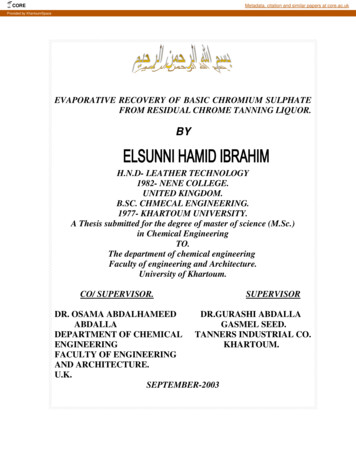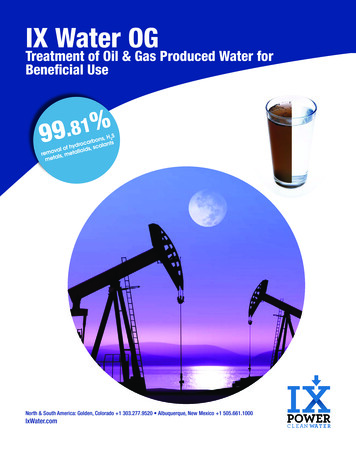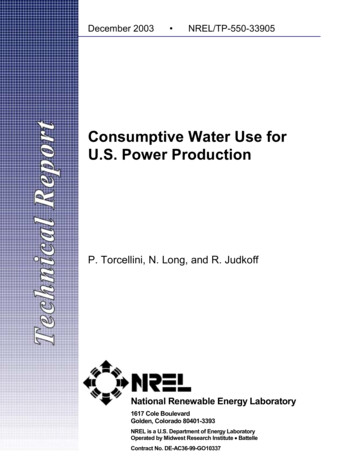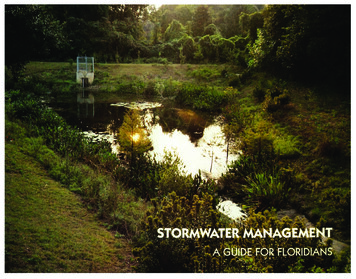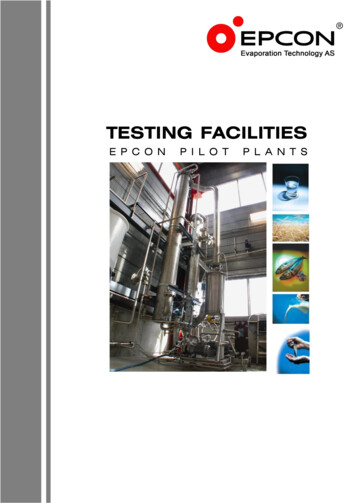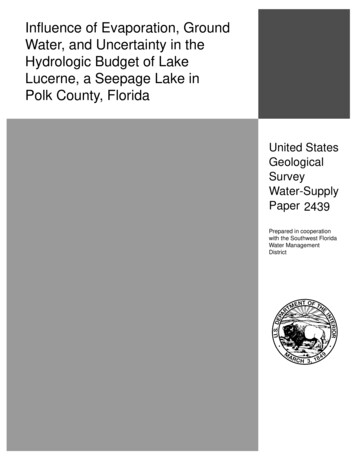
Transcription
Influence of Evaporation, GroundWater, and Uncertainty in theHydrologic Budget of LakeLucerne, a Seepage Lake inPolk County, FloridaUnited StatesGeologicalSurveyWater-SupplyPaper 2439Prepared in cooperationwith the Southwest FloridaWater ManagementDistrict
AVAILABILITY OF BOOKS AND MAPS OF THE U.S. GEOLOGICAL SURVEYInstructions on ordering publications of the U.S. Geological Survey, along with prices of the last offerings, are given in the currentyear issues of the monthly catalog “New Publications of the U.S. Geological Survey.” Prices of available U.S. Geological Survey publications released prior to the current year are listed in the most recent annual “Price and Availability List.” Publications that may be listed invarious U.S. Geological Survey catalogs (see back inside cover) but not listed in the most recent annual “Price and Availability List” maybe no longer available.Order U.S. Geological Survey publications by mail or over the counter from the offices given below.BY MAILOVER THE COUNTERBooksBooks and MapsProfessional Papers, Bulletins, Water-Supply Papers, Techniques of Water-Resources Investigations, Circulars, publicationsof general interest (such as leaflets, pamphlets, booklets), singlecopies of Earthquakes & Volcanoes, Preliminary Determination ofEpicenters, and some miscellaneous reports, including some of theforegoing series that have gone out of print at the Superintendentof Documents, are obtainable by mail fromBooks and maps of the U.S. Geological Survey are availableover the counter at the following U.S. Geological Survey EarthScience Information Centers (ESIC), all of which are authorizedagents of the Superintendent of Documents:U.S. Geological Survey, Information ServicesBox 25286, Federal Center, Denver, CO 80225Subscriptions to periodicals (Earthquakes & Volcanoes andPreliminary Determination of Epicenters) can be obtained ONLYfrom theSuperintendent of DocumentsGovernment Printing OfficeWashington, DC 20402(Check or money order must be payable to Superintendent ofDocuments.) ANCHORAGE, Alaska—Rm. 101, 4230 University Dr. LAKEWOOD, Colorado—Federal Center, Bldg. 810 MENLO PARK, California—Bldg. 3, Rm. 3128, 345Middlefield Rd. RESTON, Virginia—USGS National Center, Rm. 1C402,12201 Sunrise Valley Dr. SALT LAKE CITY, Utah—Federal Bldg., Rm. 8105, 125South State St. SPOKANE, Washington—U.S. Post Office Bldg., Rm. 135,West 904 Riverside Ave. WASHINGTON, D.C.—Main Interior Bldg., Rm. 2650, 18thand C Sts., NW.Maps OnlyMapsFor maps, address mail orders toU.S. Geological Survey, Information ServicesBox 25286, Federal Center, Denver, CO 80225Maps may be purchased over the counter at the followingU.S. Geological Survey offices: ROLLA, Missouri—1400 Independence Rd. STENNIS SPACE CENTER, Mississippi—Bldg. 3101
Influence of Evaporation, Ground Water, andUncertainty in the Hydrologic Budget ofLake Lucerne, a Seepage Lake inPolk County, FloridaBy T.M. LEE and AMY SWANCARPrepared in cooperation with theSouthwest FloridaWater Management DistrictU.S. GEOLOGICAL SURVEY WATER-SUPPLY PAPER 2439
U.S. DEPARTMENT OF THE INTERIORBRUCE BABBITT, SecretaryU.S. GEOLOGICAL SURVEYGordon P. Eaton, DirectorAny use of trade, product, or firm names in this publication is fordescriptive purposes only and does not imply endorsement by theU.S. Government.Printed in the Eastern Region, Reston, Va.UNITED STATES GOVERNMENT PRINTING OFFICE, WASHINGTON : 1997For sale by theU.S. Geological Survey, Information ServicesBox 25286, Federal CenterDenver, CO 80225Library of Congress Cataloging in Publication DataLee, T.M. (Terrie Mackin)Influence of evaporation, ground water, and uncertainty in the hydrologic budgetof Lake Lucerne, a seepage lake in Polk County, Florida / by T.M. Lee and AmySwancar.p.cm. —(U.S. Geological Survey water-supply paper ; 2439)“Prepared in cooperation with the Southwest Florida Water Management District.”Includes bibliographical references.Supt. of Docs. no: I 19.13:W24391. Hydrologic cycle—Florida—Lucerne, Lake (Polk County)I. Swancar, Amy. II. Southwest Florida Water Management District. III. Title.IV. Series.GB848.L44 1996551.48'09759'67—dc2094-40179CIP
CONTENTSAbstract.Introduction .Purpose and Scope.Previous Investigations.Acknowledgments .Description of Study Area .Physical Setting .Climate.Hydrogeologic Setting .Geologic Framework .Ground-Water Flow Patterns .Hydrologic-Budget Approach .Evaporation.Energy-Budget Method .Theory and Equations.Energy-Budget Evaporation Rates .Comparison of Thermal Survey Period and Daily Evaporation Estimates .Energy-Budget Error Analysis .Sensitivity Analysis .Mass-Transfer Method.Theory and Equations.Mass-Transfer Coefficient .Comparison of Mass-Transfer and Energy-Budget Evaporation Rates.Stability.Mass-Transfer Evaporation Rates.Mass-Transfer Error Analysis.Pan-Evaporation Method .Theory and Equations.Free Water-Surface Evaporation Rates.Pan Coefficients.Evaporation Summary .Ground Water.Numerical Simulation of Ground-Water and Lake Interactions.Modeling Approach.Effect of Intermediate Confining Unit Below the Lake .Effect of Anisotropy in the Surficial Aquifer .Effect of Lake Sediments.Limitations of Two-Dimensional Model .Summary of Modeling Results .Quantification of Ground-Water Fluxes .Ground-Water Inflow.Flow-Net Assumptions .Ground-Water Inflow Rates.Errors in Ground-Water Inflow Rates.Lake Leakage.Flow-Net Assumptions .Estimation of Sublake Vertical Hydraulic Conductivity .Leakage Rates.Errors in Lake Leakage Rates.Summary of Ground-Water 4848III
Influence of Evaporation, Ground Water, and Uncertainty in the Hydrologic Budget.Hydrologic-Budget Results.Evaluation of Budget Error .Revised Estimates of Ground-Water Inflow and Leakage .Summary and Conclusions.References .Appendix A. Energy-Budget Components and Evaporation Calculations for Each Thermal Survey Period .Appendix B. Conversion Tables for Calculation of Free Water-Surface Evaporation Rates.4949515253555860FIGURES1, 2. Maps showing:1. Location of Lake Lucerne and physiographic divisions in Polk County .2. Lakes in the vicinity of the study area .3, 4. Graphs showing:3. Monthly rainfall at Lake Lucerne for the 1986 water year and the long-term averagemonthly rainfall at the National Oceanic and Atmospheric Administration climate station atLake Alfred, 1951–80 .4. Daily mean stage of Lake Lucerne and weekly stage of Terrie Pond for the 1986 water year.5. Hydrogeologic section of the study area .6–9. Maps showing:6. Locations of wells whose logs were used to construct the hydrogeologic section .7. Bathymetric and seismic-reflection contours and cross section of Lake Lucerne .8. Data-collection sites in the Lake Lucerne study area.9. Configuration of the water table in the Lake Lucerne area based on the minimum and the maximumrecorded water levels during the 1986 water year .10–12. Sections showing:10. Vertical distribution of head during high water-level conditions, October 17, 1985 .11. Vertical distribution of head during low water-level conditions, May 20, 1986.12. Vertical distribution of head showing downward head gradient conditions, August 6, 1985.13–23. Graphs showing:13. Water levels in well 2PN-130 from April 1984 through September 1986 and the estimated trend inwater levels for nonpumping conditions .14. Daily average energy-budget evaporation at Lake Lucerne by thermal survey period for the1986 water year .15. Daily energy-budget evaporation at Lake Lucerne for 321 days of the 1986 water year .16. Daily average temperature difference and vapor pressure difference between thesurface of Lake Lucerne and 2 meters above the lake surface for the 1986 water year .17. Daily average Bowen ratios and average Bowen ratios by thermal survey period for the1986 water year .18. Sensitivity of energy-budget evaporation to errors in incident shortwave radiation, reflectedshortwave radiation, reflected and emitted longwave radiation, incident longwave radiation,Bowen ratio, and water-surface temperature.19. Relation between energy-budget evaporation and the mass-transfer product by thermalsurvey period .20. Relation between the mass-transfer coefficient and the stability parameter by thermalsurvey period .21. Mass-transfer evaporation rates corrected for atmospheric stability by thermal survey period for the1986 water year .22. Differences between energy-budget evaporation and mass-transfer evaporation (uncorrected),and mass-transfer evaporation corrected for atmospheric stability by thermal survey period forthe 1986 water year .23. Monthly free water-surface evaporation calculated from the evaporation pans at Lake Lucerneand at the Lake Alfred National Oceanic and Atmospheric Administration site, and from thecorrected energy-budget evaporation for the 1986 water 42426
24. Schematic layout of model grid for numerical ground-water simulation and enlarged model area aroundLake Lucerne showing approximate locations of wells at sites 1PN and 2PN .25–30. Diagrams of simulated vertical head distribution for:25. High water-level conditions with a continuous confining unit beneath Lake Lucerne anda breached confining unit beneath Lake Lucerne .26. High water-level conditions showing general pattern of ground-water flow in the basin .27. Low water-level conditions with a continuous confining unit beneath Lake Lucerne anda breached confining unit beneath Lake Lucerne .28. High water-level conditions with anisotropy equal to 10, 100, and 1,000.29. High water-level conditions with vertical hydraulic conductivity of the sediment, Kv ,sedequal to 0.005, 0.002, and 0.0002 foot per day .30. Low water-level conditions with vertical hydraulic conductivity of the sediment, Kvsed,equal to 0.005, 0.002, and 0.0002 foot per day .31. Flow-net diagrams for the 1986 water year annual average, for May 20, 1986, and for June 24, 1986,water-table configurations .32. Graph showing monthly and total annual ground-water inflow to Lake Lucerne for the 1986 water year .33. Schematic of conceptual model of the leakage from Lake Lucerne.34–41. Graphs showing:34. Predicted monthly mean, minimum, and maximum daily values of the head in well 1PN-155for the 1986 water year .35. Predicted monthly mean, minimum, and maximum daily values of the downward head differencebetween Lake Lucerne and well 1PN-155 for the 1986 water year .36. Monthly and total annual leakage from Lake Lucerne for the 1986 water year .37. Monthly and total annual leakage from Lake Lucerne under hypothetical, nonpumping conditionsfor the 1986 water year .38. Monthly and total annual net ground-water flow to Lake Lucerne for the 1986 water year .39. Monthly values of hydrologic-budget components of Lake Lucerne for the 1986 water year:precipitation, evaporation, change in storage, leakage, and ground-water inflow.40. Relation between the residual net ground-water flow and the calculated net ground-water flowto Lake Lucerne by month for the 1986 water year .41. Monthly calculated, residual, and revised net ground-water flow to Lake Lucerne for the1986 water year .A1, A2. Graphs showing:A1. Total stored heat and daily average change in stored heat in Lake Lucerne by thermal surveyperiod for the 1986 water year .A2. Total stored heat and daily change in stored heat in Lake Lucerne for the 1986 water year .3032333436383943444647474747485052525959TABLES1. Monthly energy-budget evaporation rates and errors, October 1985 through September 1986 .2. Monthly and annual pan coefficients for Lake Lucerne for the 1986 water year.3. Predicted ground-water inflow and leakage rates and areas for three modeled values of anisotropyat high water-level conditions.4. Predicted ground-water inflow and leakage rates for three Kv values under high and low water-levelsedconditions and heads for the midlake well .5. Monthly residual net ground-water flow to Lake Lucerne and the associated error .A1. Summary of energy-budget components and evaporation calculations for each thermal survey period .A2. Annual average values, weighted average errors, and relative errors for energy-budget componentsand evaporation, October 1985 to September 1986.B1. Conversion table for calculating monthly total free water-surface evaporation from monthlytotal pan evaporation at Lake Lucerne.B2. Conversion table for calculating monthly total free water-surface evaporation from monthlytotal pan evaporation at Lake Alfred National Oceanic and Atmospheric Administration site .B3. Conversion table for calculating monthly free water-surface evaporation from monthlyenergy-budget evaporation .Contents20273740525859606061V
CONVERSION FACTORS, VERTICAL DATUM, AND ADDITIONAL ABBREVIATIONSMultiplyinch (in.)inch per day (in/d)inch per year (in/yr)foot (ft)foot per day (ft/d)mile (mi)square foot (ft2)square mile (mi2)cubic foot per day (ft3/d)cubic foot per day per foot [(ft3/d)/ft]million gallons (Mgal)calorie per square centimeter per day [(cal/cm2)/d]calorie per gram (cal/g)calorie per gram per degree Celsius [(cal/g)/ C]gram per cubic centimeter (g/cm3)millibar (mb)ByTo obtain2.542.542.540.30480.3048centimetercentimeter per daycentimeter per yearmetermeter per 0.001120.0145kilometersquare metersquare kilometercubic meter per daycubic meter per day per metercubic meterBritish thermal unit per square foot per dayBritish thermal unit per pound massBritish thermal unit per pound mass perdegree Fahrenheitpound mass per cubic inchpound-force per square inchTemperature conversions for degrees Fahrenheit ( F) and degrees Celsius ( C) follow: C 5/9 x ( F - 32) F 1.8 C 32Sea level: In this report, “sea level” refers to the National Geodetic Vertical Datum of 1929 (NGVD of 1929)--a geodeticdatum derived from a general adjustment of the first-order level nets of both the United States and Canada, formerly calledSea Level Datum of 1929.Additional units used in report:cmcm/dmcentimetercentimeter per daymeterNOTE: Inch-pound units were selected for use in this report. An exception to the use of inch-pound units, however, ismade in the presentation of data collected for the energy-budget and mass-transfer evaporation methods. The metric unitof langley (calories per square centimeter) is conventionally used to describe the energy terms in an energy-budgetanalysis (Anderson, 1954; Sturrock, 1985). Temperatures used in the computation of energy terms are in the compatiblemetric unit of degrees Celsius. The dual units that are conventionally used to describe the components of the mass-transfer evaporation method (Harbeck, 1964; Sturrock, 1985) also are used in this report.VIContents
Influence of Evaporation, Ground Water, andUncertainty in the Hydrologic Budget of Lake Lucerne,a Seepage Lake in Polk County, FloridaBy T.M. Lee and Amy SwancarAbstractEvaporation losses and the interaction ofground water with Lake Lucerne were studied todetermine the influence of these two processes onthe hydrologic budget of a seepage lake. LakeLucerne is representative of the numerousseepage lakes of sinkhole origin in the karstterrain of central Florida. Because of permeablesurficial deposits, ground-water inflow is the onlysignificant contribution from the surroundingwatershed. The lake recharges the underlyingUpper Floridan aquifer and, as a result, issusceptible to increased leakage induced bypumping from this aquifer. Ground-water fluxesdetermined in the study were analyzed to definethe proportion of the total lake leakage induced bypumping from the Upper Floridan aquifer. Ahydrologic budget is analyzed for the 1-yearperiod from October 1985 to September 1986.Ground-water inflow and leakage aresignificant components of the hydrologic budget.Changes in the quantity of either of these fluxescan substantially alter lake stage. Ground-waterinflow contributed from 20 to 37 percent of thetotal annual inflow to the lake. Leakage from thelake accounted for 18 to 23 percent of the totalannual outflow. Water withdrawals from theUpper Floridan aquifer increased annual lakeleakage by 22 percent over nonpumpingconditions. Most of the increase (92 percent) inleakage occurred during April, May, and June1986, when local citrus irrigation was highest.For the study year, ground-water inflow andleakage volumes were calculated by flow-netanalysis to be equal to 10.5 and 12.6 inches,respectively, of water depth above (or below) thelake surface. These estimates were revisedupward on the basis of an analysis of the error inthe hydrologic-budget equation. Revised groundwater inflow exceeded annual leakage from thelake. Ground-water inflow rates were increasedby 120 percent to 23.6 inches, and leakage wasincreased by 40 percent to 17.5 inches.Differences between the two estimates probablyreflect the uncertainty in the hydraulicconductivity estimates of the porous mediaaround the lake and the unaccounted effect oftransient ground-water inflow.The geometry of the sinkhole complexbeneath Lake Lucerne and pumping in the UpperFloridan aquifer are primary controls on groundwater interactions with the lake and, in particular,lake leakage. A numerical ground-water modelwas used to test the effects of these two factors onground-water interactions with the lake. Resultsindicate that the intermediate confining unitbelow Lake Lucerne has been breached andreplaced by materials about two orders ofmagnitude more conductive. Anisotropy in thesurficial aquifer is approximately 100 andcontrols the depth of the ground-water flowintercepted by the lake. Lake sediments havinglow permeability may control the distribution ofleakage through the lakebed but did notappreciably reduce total leakage rates in thesesimulations.Abstract1
Evaporation loss was the major outflowcomponent of the hydrologic budget. Annual lakeevaporation determined by the energy-budgetmethod was 57.9 inches, about 8 inches greaterthan long-term estimates for the region. Thegreater rate was attributed to drier than normalconditions: rainfall totaled 40.9 inches during thestudy year, about 10 inches less than thelong-term average. Similar annual evaporationrates were determined by the energy-budgetmethod, the simpler mass-transfer method, and bycorrected pan evaporation from an onsite pan;however, the probable errors associated with theseother two methods were greater than for theenergy budget. Weekly energy-budgetevaporation rates ranged from 0.04 inch per dayin early January 1986 to 0.26 inch per day in earlyMay 1986. The largest monthly energy-budgetevaporation rates occurred in April and May1986, 7
Lee, T.M. (Terrie Mackin) Influence of evaporation, ground water, and uncertainty in the hydrologic budget of Lake Lucerne, a seepage lake in Polk County, Florida / by T.M. Lee and Amy Swancar. p. cm. —(U.S. Geological Survey water-supply paper ; 2439) "Prepared in cooperation with the Southwest Florida Water Management District."
